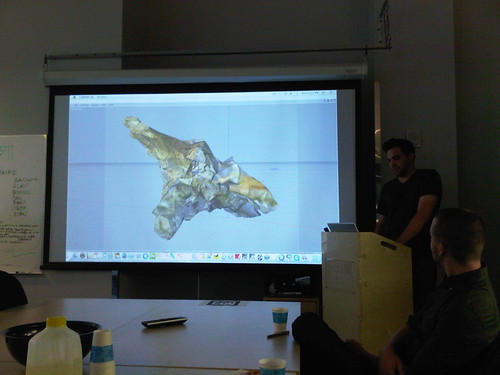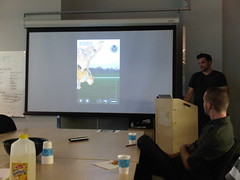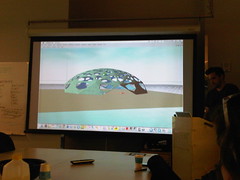
Virtual Public Art Project (VPAP), in collaboration with Breadboard, is on its way to Philadelphia, debuting in a limited capacity as part of Design Philadelphia 2010 and then going citywide in the spring of 2011. On September 1, I attended a talk and demonstration at NextFab Studio by Chris Manzione, the founder of VPAP. To say my mind was blown would be an understatement. I was already peripherally aware of VPAP since last year, without knowing much of what is was or how it actually functioned. Learning about the project and the technology that makes it possible opened my eyes to a world of promise for its use in arts and culture.
Manzione spoke of the author William Gibson’s influence, as well as the emergence of locative media, on his desire to place public art into virtual space. In Gibson’s novel Spook Country, artists place geo-tagged, three-dimensional virtual models of celebrities at their death sites, such as River Phoenix’s slumped body outside of the Viper Room; the models are viewable through head-mounted displays attached to GPS devices. The rapid technological advancement of smartphones, paired with their mass proliferation on the open market, has propelled the concept of locative art out of speculative fiction and into the realm of possibility.


VPAP relies on Layar, an Augmented Reality (AR) browser available to iPhones and Droids (which makes this Blackberry user very dejected). Using the live camera feed on these phones, Layar software pulls information based on a user’s exact location via GPS positioning, and overlays geo-tagged information about the things in that immediate environment. Let’s say you hold your phone up to a city block and search for a coffee shop: the software will pinpoint matching locations. You are not looking at a grid or a map; you are looking at the real time street view through the phone’s display screen. It can also link to related information like menus, customer reviews, or the café’s Twitter feed. Eventually (and alarmingly), software like Layar could have the ability to pull up information about other people in the immediate vicinity, if data stored on their personal electronic devices is not properly protected. Imagine looking at a stranger on the bus and a text bubble pops up over his or her head which instantly displays phone number, email, and Facebook profile.

It was with the mission of placing site-specific, three-dimensional art into virtual space, that Manzione founded VPAP. The art can be based upon a real world object that has been scanned into a digital model, or it can be designed entirely on the computer. He began by digitizing small sculptures, scaling them up in size, and placing them in virtual spaces that corresponded to actual geographic coordinates. When looking at the virtual art through a smartphone, its presence behaves much like that of a physical object might, becoming larger or smaller based on the distance one stands from it. In the case of Veiled Presence—a giant, perforated dome placed on an open field in New Jersey—one can walk into and through the dome, looking up through the holes towards the sky (see above photo).
Video via VPAP on Youtube
The newness of the technology makes virtual space something of a wild west. Presently, there is no restriction or rule of law and every inch of space in our real world remains a stake to be claimed in the parallel virtual world. Anyone can place anything into virtual space that corresponds with a real world location, remaining invisible to the naked eye until viewed with the appropriate technology interface. Herein exists the exciting and transgressive potential of virtual public art. Forget about zoning, permits, material, and labor. Forget about commissioning the artist; you can be the artist! Simply proceed to create and place your art into virtual space at will. It is only natural to foresee a future in which programs will exist with out of the box capability for users to easily design, install, or curate their own collections of virtual art. On Foursquare, any user can already add an object or location, no matter how insubstantial. Want to be the mayor of a street sign? You simply add it and check-in repeatedly. Does virtual mayoralty acquired through heavy or repeated usage of a place (i.e. being a “regular” there) constitute some kind of ownership?
Manzione himself is interested in ownership of virtual space and using AR to put objects into restricted areas. Artist Christian Meinhart has explored the concept for VPAP with his project Cargo, designing virtual totems out of digitized freight containers, inspired by tribal “cargo cults”. He positioned the sculptures on inhospitable industrial wasteland settings inaccessible to the average person, such as Chernobyl. Among other aspects of the work, Meinhart is reclaiming for the virtual world areas that have been made desolate and toxic in the physical world.
It was at about this point in the presentation that Dan Schimmel, the director of Breadboard and Esther Klein Gallery, astutely remarked that there is no restriction preventing a company like Verizon from plastering a massive logo on top of the rival Comcast building in virtual space. Marketing messages are thrust upon us everywhere we go; virtual space is the next frontier and it is an eventuality we all should dread. What is to stop a corporation from littering your home and personal space with its advertising? Marketing is already being used to limited effect in AR and its prevalence will surely grow.
Those concerns aside, the arts and culture applications for Augmented Reality are incredibly exciting, only constrained by the imagination and the capacity of the software. Audio and virtual tour applications already developed by some museums will look old and obsolete compared with what AR could provide given a few more years. You could hold your phone up in a gallery and instantly access voluminous information about the art and artist, time period in which it was made, the style or movement, and suggestions of similar artwork that you might like. Now go beyond what we think is already possible in a museum experience. Imagine overlaying sketches or studies the artist did for the work, or even videos of the artist’s process. How about comparing one work against the artist’s virtual catalogue raisonné, instantly accessing hundreds or thousands of items scattered amongst collections all over the world? Curators and experts could pop up as talking heads to give even more context.
Historic sites are prime candidates for making the most of the technology. Rather than using it to fabricate something new, AR can be used to overlay virtual recreations of structures no longer in existence. The Classicist in me immediately thinks of ancient civilizations: as tourists stroll through the Roman Forum or the Athenian Acropolis, they could see the ruins restored to their glory days. Objects from our not so distant past are already being resurrected, such as this virtual model of the Berlin Wall. The September 11 Memorial just released an AR-enhanced app in time for the ninth anniversary of the national tragedy.
As long as it remains an open platform, virtual public art has the makings of a democratizing force, if not in the physical world, then in a cyber realm where we spend increasing increments of our time. But at this point, its accessibility is limited to populations who own the two specific types of smartphones mentioned previously. As of the first quarter of 2010, smartphone penetration comprised only 23% of the mobile phone market, but its share is rising steadily. (source: Nielsen) The audience for AR-enhanced arts and culture experiences, such as VPAP, is primed and will continue to grow. I hope that for inclusivity developers will consider all phone operating systems when developing software that delivers AR experiences.
No comments:
Post a Comment